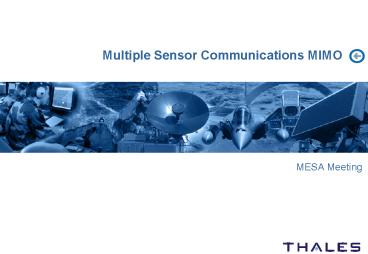Multiple Sensor Communications MIMO - PowerPoint PPT Presentation
1 / 7
Title:
Multiple Sensor Communications MIMO
Description:
Sub optimal MMSE : Rayleigh Channel. Normalizing the transmitting power (P constant nb Tx) ... compared to the SISO system with a sub-optimal low cost receiver ... – PowerPoint PPT presentation
Number of Views:56
Avg rating:3.0/5.0
Title: Multiple Sensor Communications MIMO
1
Multiple Sensor Communications MIMO
- MESA Meeting
2
Our proposal
- Provide a low cost system with the necessary
throughput - Rely on existing standards
- Increase the system capacity with limited system
impact - Specialise an existing system to fulfil the MESA
like system requirements - MESA wireless system should cope with many
transmissions scenarios - Large-short coverage
- Indoor and out door
- We propose to adapt the 802.16 standard
- Increase rate with
- Limit the system impact at the access point
3
MESA transmission context
- Provide high data rate transmission
- Many propagation scenarios
- Indoor
- Indoor to outdoor
- Outdoor
- Privilege the uplink
- Changes form the mass market considerations
- Coverage
- Form 100 m to few Km
- Central access point
4
Different MIMO contexts
- Diversity coding point to point multiplexing
- Pros
- Full diversity codes exist (for codes)
- Rate increase
- No synchronisation issues
- Cons
- No benefit when no diversity (few scatters)
- Large existing standard modifications
- Where to put the antennas
- Multi-user transmissions (multi-point to point)
- Pros
- Capacity increase
- Terminals can be standard (ex low cost 802.16)
- Complexity at the access point
- Works even with no scatters (SDMA like)
- Cons
- System synchronisation between the transmitters
- Exists in TDMA/TDD systems
5
Operational contexts Spatial diversity
- The technique should be adapted to the
environment - No scatters
- SDMA well suited
- Multiplexing (multi-point to point)
- - Multiplexing (point to point)
- - Diversity coding
- Channel with few scatters
- Multiplexing (multi-point to point)
- ? Diversity coding
- ? Multiplexing (point to point)
- - SDMA
- Channel with many scatters
- Multiplexing (multi-point to point)
- Diversity coding
- Multiplexing (point to point)
- - SDMA
6
Sub optimal MMSE Rayleigh Channel
- Normalizing the transmitting power (P constant ?
nb Tx) - For a given power the system capacity is
increased. Identical performance are achieved
compared to the SISO system with a sub-optimal
low cost receiver - Further improvements in range/robustness/coverage
are achievable with a little more complexity in
the receiver
P
P/3
P/3
P/3
P/4
P/4
P/4
P/4
Eb/No for one user
7
Conclusions
- The simultaneous multiple user transmission
technique seem the better adapted to increase the
capacity of existing standards (802.16) - Provides enhancements in all transmission
scenarios - MESA mainly outdoor or indoor to outdoor
- Provides large systems improvements with minor
changes to existing standards - The terminals need a minor layer 1 and 2
modification - Privileges the uplink
- The complexity is deported to the access point
- Low cost terminals allow larger access to the
system































